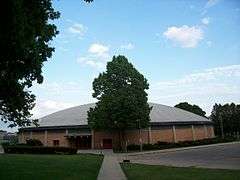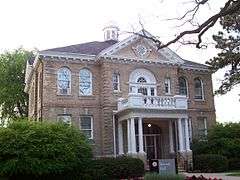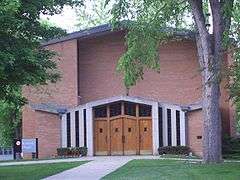Wayland Academy, Wisconsin
Wayland Academy is a private, coeducational college preparatory boarding high school located in Beaver Dam, Wisconsin, United States. The student population at the beginning of the 2011–12 school year was 220.
| Wayland Academy | |
|---|---|
 | |
| Location | |
Beaver Dam , Wisconsin United States | |
| Information | |
| Type | Independent, coeducational boarding/day school |
| Motto | Knowledge and Character |
| Established | 1855 |
| President | Joseph A. Lennertz |
| Faculty | 28 teachers |
| Enrollment | 220 students (72% boarding, 28% day) |
| Average class size | 13 |
| Student to teacher ratio | 7:1 |
| Campus | 65 acres (260,000 m2) |
| Color(s) | Red and White |
| Athletics | 12 interscholastic sports teams |
| Athletics conference | Trailways East, Trailways Small (Football) |
| Mascot | Big Red |
| Accreditation | ISACS,[1] NCA CASI[2] |
| Yearbook | Pillars |
| Matriculation Rate | 100% of Wayland Academy seniors are accepted to four-year universities |
| Website | wayland |
History
Wayland Academy was chartered as Beaver Dam Academy by the legislature of Wisconsin Territory in 1847, by a group which included Parker Warren (soon to be elected to the legislature of the newly admitted State of Wisconsin) and other local dignitaries. The charter provided that no religious test could be required of any officer or trustee of the corporation, or of any student.[3]
It was founded as a Baptist university,[4] though it is now a non-denominational high school. The cornerstone of Wayland Hall was laid in 1855, marking the beginning of a new institution aimed at increasing the number of Midwestern students at Baptist seminaries.
Wayland was closed twice, once during the Civil War, and once during the Great Depression. During the 1960s, it became known as Wayland Junior College. After including a middle school in the 1980s, Wayland became the college preparatory high school that it is today. It celebrated its sesquicentennial in 2005.
Camp Beaver Dam, a WWII POW camp, was constructed in the summer of 1944 on the grounds of what is now the Wayland Academy field house. The POW camp held 300 German prisoners of war in a tent city encampment.[5]
Campus
Wayland's 65-acre (260,000 m2) campus is located near downtown Beaver Dam. It consists of north and south halves divided by Hwy. 33. North Campus, the school's original land, is home to most of the campus buildings. It has separate buildings for different academic faculties, dormitory space, administration, and student life. South Campus, a former fairgrounds, consists of athletic fields and the school's field house.
Academic facilities
The Academic Building and Swan Library are the newest buildings on campus, completed in 1989. The Academic building houses the departments of mathematics, English, history, and modern and classical languages. Swan Library contains a student computer lab in addition to the 21,000 volume collection, including roughly 60 periodicals, and having first issue copies of several major magazines such as National Geographic.
In recent years Kimberly Chapel has served primarily as home to the music department and as a meeting place for the student body. Built in 1958, the chapel is used for weekly assemblies and chapel services, as well as the annual Festival of Lessons and Carols, modeled after the original service at King's College in Cambridge, England. The chapel contains practice rooms and music studios on the lower level, while the chapel proper, with a Steinway Model B piano and a three-manual Moeller pipe organ, often functions as a music performance space,.
Discovery Hall was dedicated in 1971 and is home to the science department. In addition to laboratories and classrooms, it contains a lecture hall and an observatory.
Residence halls and student life facilities

The oldest building on campus is Wayland Hall. Originally constructed in 1855, it was for a time the sole building serving the school, and housed classrooms, bedrooms, a chapel, and a kitchen. It has been remodeled several times, and now serves as a dormitory for first-year and sophomore boys. The building was renovated in 2009, creating a modernized dorm with more comfortable living spaces for its residents.[6] This building remains the school's most recognizable structure due to its four large Corinthian pillars, each of which represents a fundamental element in the Wayland community: Scholarship, Faith, Health, and Service.[7]
Wayland Hall is the first building along the campus's semicircular drive; the second is the Lindsay Gymnasium complex. The original gymnasium dates from 1899 and has since been converted to a student union, dance hall, and art studio. The Sol Wolfe 1934 Memorial Pool and a newer gymnasium housing the school's theater are adjacent to the original gym building.
Warren Cottage was originally constructed as a girls' residence hall in 1888 and has since received several additions and renovations. It is still a dormitory for first-year and sophomore girls, and its lower level contains Pickard Dining Hall, a day students' lounge, and the bookstore and post office.
The twin dormitories, Glen Dye and Ella Dye, opened in the 1960s and house junior and senior students; the men live in Ella Dye and the women in Glen Dye. Student rooms are arranged in a suite-like fashion, with two rooms connected by a private bathroom. Both dorms recently underwent extensive interior remodeling and furniture replacement.
Completed in 1901, Roundy Hall was originally a music building and chapel built partially from funds donated by the Roundy family of Roundy's Foods. It now houses administrative offices, including the president's office, the Office of Admissions, the CFO, and the Vice-President of Development.
Other buildings on North Campus include the President's House and Schoen House, the student health center.
The primary building on the 26-acre (110,000 m2) South Campus is the field house, built in 1967. Adjacent to it are the school's eleven tennis courts and athletic fields. An additional field, Brown Field, is located on North Campus and is used for football and field hockey.
Academics
Wayland's academic program focuses on preparing its students for undergraduate colleges and universities upon graduation. The class schedule consists of eight 45-minute periods whose order rotates daily. Classes are offered on three levels: college preparatory, honors, and advanced placement (AP). Graduation requirements include four years of English, and three years each of mathematics, social science/history, natural sciences, and languages. Languages offered include Spanish, German, and advanced study in Latin and Greek. Additionally, all students must have at least one year of Latin instruction to graduate. Students must also complete the equivalent of one year's study of fine arts through music or studio art courses or lessons.[8] The school offers 15 classes at the advanced placement level, and approximately 80% of its faculty have attained advanced degrees in their fields.[9]
In 2015 the school joined the Hybrid Learning Consortium.[10] It creates a globalized learning community offering a diverse variety of online courses to students around the world.
Student life
Roughly 15% of Wayland's student body are students are racial minorities, and roughly 20% of Wayland students are international students.[11]
Wayland's dress code includes dress clothes during the school day and on formal occasions. Wayland provides its boarding students with 19 meals weekly, and traditionally holds formal or family style meals every few weeks. Students eat at least one meal a week with their faculty mentor, a faculty member who serves as an academic and all-purpose adviser to help students with concerns ranging from homework to social issues.
Extracurricular activities are offered. Organizations include concert band, pep band, strings chamber ensemble, Thespian Society, student newspaper, student literary magazine, and student government. In addition to the required weekly chapel service, an optional weekly prayer service and a breakfast bible study exist for students with a stronger spiritual life.
Traditions
- The Victory Bell is a large bell located near the middle of campus. It is rung following athletic victories, the last class period for seniors before graduation, and any other significant cause for celebration.
- The Axe Hunt is an annual event held in late spring, where students from the graduating class hide a wooden axe somewhere on the Wayland campus. The junior students follow clues hidden throughout the city of Beaver Dam to find the axe before a set time. If the juniors find the axe, they receive a week of relaxed dress code.
- Each year the school year has begun with orientation, a weekend of difficult team-work based games and activities. The games are run by returning faculty and students. This event dates back more than fifty years.
- Every year ends with a Senior Chapel, when Senior students sing some, give inspirational speeches, and reflect on their past time at Wayland to the underclassmen.
Athletics
In lieu of physical education courses, all Wayland students participate in extracurricular athletic activities in each season of the year. In addition to offering an alternative activities program, the following team sports are offered:
|
Fall:
|
Winter:
|
Spring:
|
Notable alumni
Government
- Cyrus Amir-Mokri, Assistant Secretary of the Treasury for Financial Institutions
- George Edwin Taylor, first African American to run for the United States Presidency[12]
- Michael E. Burke, congressman
- Daniel E. La Bar, Wisconsin State Representative
- John McConnell, special assistant to the President and Vice President of the United States
- John Mellen Thurston, former U.S. Senator from Nebraska
- Ernest B. Price, American diplomat and academic
- Claire B. Bird, Wisconsin State Senator
- Robert Goetsch, Wisconsin State Representative
- George F. Merrill, Wisconsin State Senator
- Charles Pettibone, Wisconsin State Senator
- Jesse Clason, Wisconsin State Representative and physician[13]
Professional sports
- Ric Flair, professional wrestler
- Emerson "Pink" Hawley, professional baseball
- Addie Joss, Baseball Hall of Fame member
- Tom Nissalke, professional basketball coach
- Jimmy Chin, professional climber and mountaineer
Business
- Ray Patterson, former General Manager of the Milwaukee Bucks and Houston Rockets
- Frederick D. Underwood, businessman
Sciences, media and the arts
- Jensen Buchanan, former soap opera star of Another World and General Hospital
- Donald Downs, professor of political science and law at the University of Wisconsin–Madison
- Zona Gale, author and playwright, recipient of the Pulitzer Prize
- Susan Peterson, former NBC and CBS foreign correspondent
References
- School Overview, ISACS website, Retrieved 2012-07-08
- Institution Summary, AdvancED, Retrieved 2012-07-08
- "AN ACT To incorporate the trustees of the Beaver Dam Academy". Laws of the Territory of Wisconsin, Together with the Joint Resolutions and Memorials Passed at the Annual Session of the Legislature in 1847 Madison: H. A. Tenney, Territorial Printer, 1847; pp. 203-207
- "Wayland Academy - History". www.wayland.org. Retrieved 2017-01-08.
- Cowley, Betty (February 2002). "Camp Beaver Dam". Stalag Wisconsin: inside WW II prisoner-of-war camps. Badger Books, LLC. p. 77. ISBN 1-878569-83-X.
In trucks under heavy military escore, 300 German PW's arrived on the 17th of June.
- Esten, Robert (Fall 2006). "Annual Report of the President". Wayland Academy Greetings. 89 (1). p. 9.
- "Wayland Academy - Facts and Features". www.wayland.org. Retrieved 2015-10-13.
- "2006-2007 Academic Register and Curriculum Guide" (PDF). Wayland Academy. 2006-07-03. Archived from the original (PDF) on 2007-09-27. Retrieved 2007-05-11. Cite journal requires
|journal=(help) - "Wayland Academy - Boarding School Profile". Boarding School Review (online). Retrieved 2007-05-12.
- "Home2". www.hybridlearningconsortium.org. Retrieved 2016-06-29.
- "Wayland Academy - Boarding School Profile".
- Mouser, Bruce Lee. "Past, Present, & Future: Newsletter of the La Crosse County Historical Society". Wisconsin Labor Advocate. Wisconsin Labor Advocate. Retrieved 18 May 2010.
- 'Wisconsin Blue Book 1897,' Biographical Sketch of Jesse Clason, pg. 675
Images
 Wayland Hall
Wayland Hall Warren Cottage
Warren Cottage Field House
Field House Roundy Hall
Roundy Hall Kimberly Chapel
Kimberly Chapel
External links
| Wikimedia Commons has media related to Wayland Academy. |